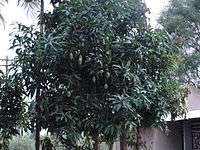Mango oil
| Saturated fats | |
|---|---|
| Total saturated | 45-50 |
| Unsaturated fats | |
| Total unsaturated | 50-55 |
| Monounsaturated | 40-46 |
| Omega-6 fatty acids | 3-4 |
| Properties | |
| Melting point | 32–43 °C (90–109 °F) |
| Solidity at 20 °C (68 °F) | semi-solid |
| Iodine value | 32.0-60.7 |
Mango oil, a.k.a. mango kernel fat,[1] or, mango butter, is an oil fraction obtained during the processing of mango butter. Mango oil is a seed oil extracted from the stone of the fruit of the Mangifera indica. The oil is semi-solid at room temperatures, but melts on contact with living skin, making it appealing for baby creams, suncare balms, hair products, and other moisturizing products. The oil is a soft yellow color with a melting point of 32–42 °C (90–108 °F).
Tree

A large green tree, valued mainly for its fruits, both green and ripe. It can grow up to 15–30 metres (49–98 ft) tall. The tree grows best in well-drained sandy loam; it does not grow well in heavy wet soils. The optimal pH of the soil should be between 5.2 and 7.5.[2]
Flowers
Flowers appear at the end of winter and beginning of spring. Both male and female flowers are borne on same tree.The Climatic conditions have significant influence on the time of flowering of mango.In India flowering starts from December in the South and in January in Bihar and Bengal, and in February in eastern Uttar Pradesh, and in February–March in northern India. The duration of flowering is 20–25 days in Dashehari, while panicle emergence occurs in early December and flower opening is completed by February. It is well known that the Neelum variety of mango produces two crops a year in Kanyakumari, in South India, but flowering only once in North Indian conditions[3]
Fruits
Fruit is an irregular egg shaped and slightly comprised fleshy drupe. Fruits are usually 8–12 cm (3–5 in) long and greenish yellow in color. Mango fruits can be round, oval, heart shaped or kidney shaped. Mango fruits are green when they are unripe. The interior flesh is bright orange and soft with a large, flat pit in the middle. [4] Mature in April and May. 210 varieties of mango species have been reported. Fruits have exported value. Raw mango can be used in the making of pickles, chutneys etc. Ripe mango is popular edible fruit all over the world. The skin and pulp will be 85% and the remaining 15% is of stone (seed) [5]
Extraction of oil

Fat is extracted from dried mango kernels by hydraulic pressure,[6] or by solvent extraction.[7] In solvent extraction, hexane, a liquid hydrocarbon, is used as the extraction medium. The collected mango stones are washed with well-water soon after collection. After washing, the seeds are sun dried to reduce the moisture content to 12-15%. The dried seed stone is roasted in a drum roaster and the hull is removed mechanically, or manually by beating with wooden clubs. The separated kernels are crushed into small pieces in a hammer mill. The mango kernel pieces are conveyed to a pellet making machine and pellets are formed. The pellets are cooled to room temperature in a cooler and are conveyed to the solvent extraction plant. Some processors produce flakes by crushing the seeds in a flaking roller mill.[8]
Composition and characteristics of oil/fat
Mango kernel oil is solid at room temperature with a melting point of (35–43 °C (95–109 °F)).
|
Physical characteristics of mango kernel oil[5]
|
Fatty acids present in mango fat[9]
|
Uses
- Can be used as a substitute for cocoa butter in chocolate manufacturing.[1][10]
See also
References
- 1 2 Jill Frank (Oct 24, 2014) "Cocoa Butter Alternatives in Chocolate", Prospector, Underwriters Laboratories
- ↑ Flowers of India
- ↑ Flowering of mango
- ↑ "Mango", Purdue University
- 1 2 SEA Hand Book 2009, Solvent Extractors' Association Of India
- ↑ Mango oil extraction
- ↑ Extraction methods
- ↑ Solvent extraction of vegetable oils
- ↑ SEA :SEA News circular Vol.2 No.3 (June 2009)
- ↑ Production of a cocoa butter equivalent